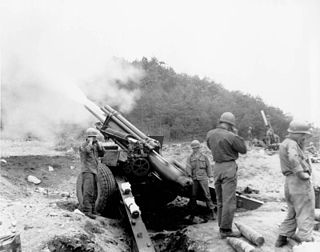
A howitzer is a long-ranged weapon, falling between a cannon, which fires shells at flat trajectories, and a mortar, which fires at high angles of ascent and descent. Howitzers, like other artillery equipment, are usually organized in a group called a battery.
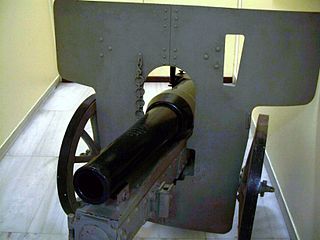
Mountain guns are artillery pieces designed for use in mountain warfare and areas where usual wheeled transport is not possible. They are generally capable of being taken apart to make smaller loads for transport by horses, humans, mules, tractors, or trucks. As such, they are sometimes called "pack guns" or "pack howitzers". During the American Civil War these small portable guns were widely used and were called "mountain howitzers".
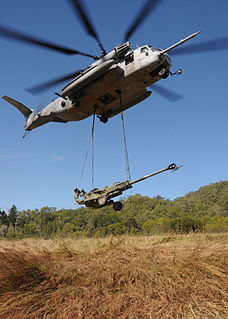
Airborne guns are airborne artillery pieces, designed for use by paratroopers. They are generally specific or specialised types of infantry support guns, being in the traditional sense capable of being broken down into smaller loads for transport by aircraft and soldiers, thus also suitable as mountain guns. The historical concept of the "airborne guns" is to some degree outdated, their role being filled by mortars, wire-guided missiles, and/or light anti-tank weapons. As it has been many decades since two industrialized great powers engaged directly in warfare, the concept of the "airborne gun" allowing paratroopers to maintain an airhead against an armored force is in that sense non-functional, but currently, all three of the U.S. Army's howitzers, are air-mobile.

This article is about the weapons used in the Vietnam War, which involved the People's Army of Vietnam (PAVN) or North Vietnamese Army (NVA), National Liberation Front for South Vietnam (NLF) or Viet Cong (VC), and the armed forces of the China (PLA), Army of the Republic of Vietnam (ARVN), United States, Republic of Korea, Philippines, Thailand, and the Australian, New Zealand defence forces, and a variety of irregular troops.

The 105 mm Howitzer Motor Carriage M7 was an American self-propelled gun vehicle produced during World War II. It was given the official service name 105 mm Self Propelled Gun, Priest by the British Army, due to the pulpit-like machine gun ring, and following on from the Bishop and the contemporary Deacon self-propelled guns.

Field artillery in the American Civil War refers to the artillery weapons, equipment, and practices used by the Artillery branch to support the infantry and cavalry forces in the field. It does not include siege artillery, use of artillery in fixed fortifications, or coastal or naval artillery. Nor does it include smaller, specialized artillery classified as small arms.

Ordnance, QF 3.7-inch howitzer is a mountain gun, used by British and Commonwealth armies in the First and Second World Wars, and between the wars.

The M101A1 howitzer is an artillery piece developed and used by the United States. It was the standard U.S. light field howitzer in World War II and saw action in both the European and Pacific theaters and during the Korean War. Entering production in 1941, it quickly gained a reputation for accuracy and a powerful punch. The M101A1 fires 105 mm high explosive (HE) semi-fixed ammunition and has a range of 12,330 yards (11,270 m), making it suitable for supporting infantry.

The OTO-Melara Mod 56 is an Italian-made 105 mm pack howitzer built and developed by OTO-Melara. It fires the standard US type M1 ammunition.

The Mortier de 280 TR Modèle 1914 Schneider was a French siege howitzer manufactured by the Schneider et Cie company, used during World War I. The howitzer had its origins from a Russian Army policy to upgrade its artillery park after the poor showing of Russian artillery in the 1904-5 Russo-Japanese war. In 1909 an agreement was signed between Schneider and the Russian armaments manufacturer Putilov to jointly develop and produce a number of artillery types. One of these types was a 279.4 mm (11-inch) siege howitzer with a range of 6,000 m (20,000 ft) to replace very old Russian guns of similar calibre. Schneider delivered the first prototype of the siege howitzer to the Russians in 1912 for extensive testing. Although the Russians found the gun was unable to penetrate the heaviest reinforced concrete fortifications its general performance was judged satisfactory which led to an order for 16 howitzers to be delivered in 1915. The French Army expressed interest in the Schneider howitzer as a possible replacement for the Mortier de 370 Mle 1885 De Bange. After some dithering by French authorities 18 howitzers were ordered in 1913. Delivery of the howitzers to Russia and France was delayed by the general mobilisation of 1914 which disrupted industrial production. During the war 126 howitzers were delivered to the French Army and 26 to Russia as the 280 mm Schneider Mortar Model 1914/15 before the 1917 revolutions. In addition another 25 barrels were installed post-WW1 on the Saint-Chamond heavy self-propelled gun chassis as the Mortier 280 mm TR de Schneider sur affût-chenilles St Chamond.

The 105 mm Howitzer M3 was a U.S. light howitzer designed for use by airborne troops. The gun utilized the barrel of the 105 mm Howitzer M2, shortened and fitted to a slightly modified split trail carriage of the 75 mm pack howitzer.

The 75mm Pack Howitzer M1 was a pack howitzer artillery piece used by the United States. Designed to be moved across difficult terrain, gun and carriage could be broken down into several pieces to be carried by pack animals.

The 10 cm M. 14 Feldhaubitze was a dual-purpose field and mountain gun used by Austria-Hungary during World War I. Between the wars it was used by Austria, Italy, and Poland. During World War II it served as the standard medium howitzer of the Royal Italian Army with the designation Obice da 100/17 modello 14 and after 1943 captured weapons were used by Nazi Germany's Wehrmacht under the designations 10 cm leFH 14(ö) and 10 cm leFH 315(i). After World War II an updated howitzer remained in service with the Italian Army until 1975.

The 7.5 cm GebG 36(German: 7.5 cm Gebirgsgeschütz 36) was a 7.5 cm (3.0 in) German mountain gun used during World War II. At least 1,193 were built between 1938 and 1945. It was the standard light gun of the German mountain divisions, both Army and Waffen-SS, during World War II.
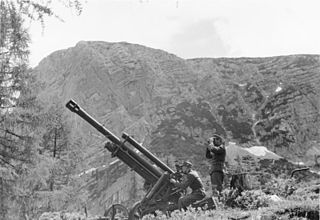
The 10.5 cm Gebirgshaubitze 40 was a 10.5 cm (4.1 in) German mountain howitzer used during World War II. A total of 420 were built during World War II. It saw action with German mountain divisions in Finland, Italy, France, on the Eastern Front and in the Balkans from 1942. It served with a number of European countries into the 1960s.
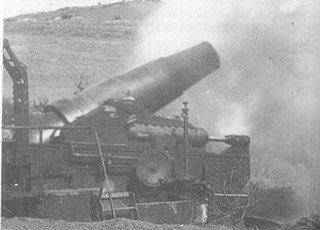
The 28 cm Haubitze L/12 was a German coastal defense and siege howitzer. Developed by Krupp before World War I that saw service in both World War I and World War II.

The M1841 mountain howitzer was a mountain gun used by the United States Army during the mid-nineteenth century, from 1837 to about 1870. It saw service during the Mexican–American War of 1847–1848, the American Indian Wars, and during the American Civil War, 1861–1865.

The T30 Howitzer Motor Carriage (HMC) was a United States Army self-propelled gun used in World War II. Its design was based on requirements for an assault gun issued by the Armored Force in 1941 and it was built as an interim solution until a fully tracked design was complete.

















